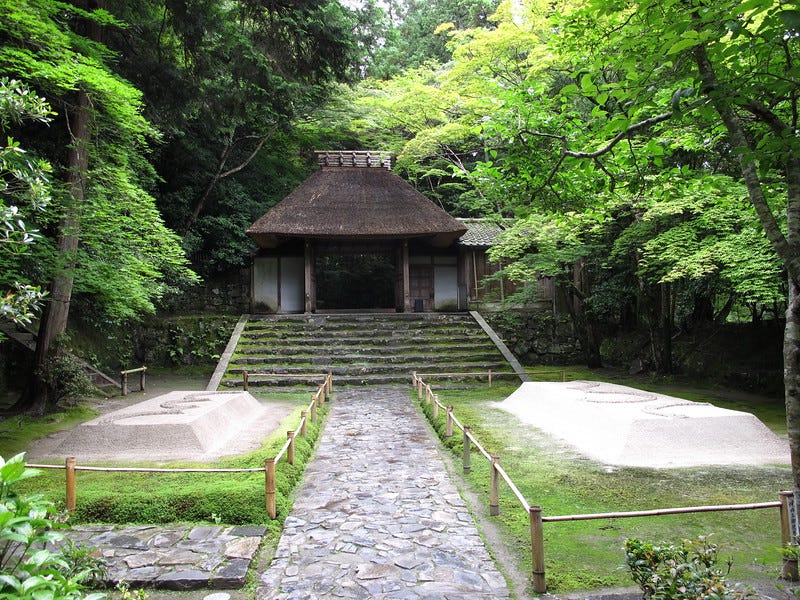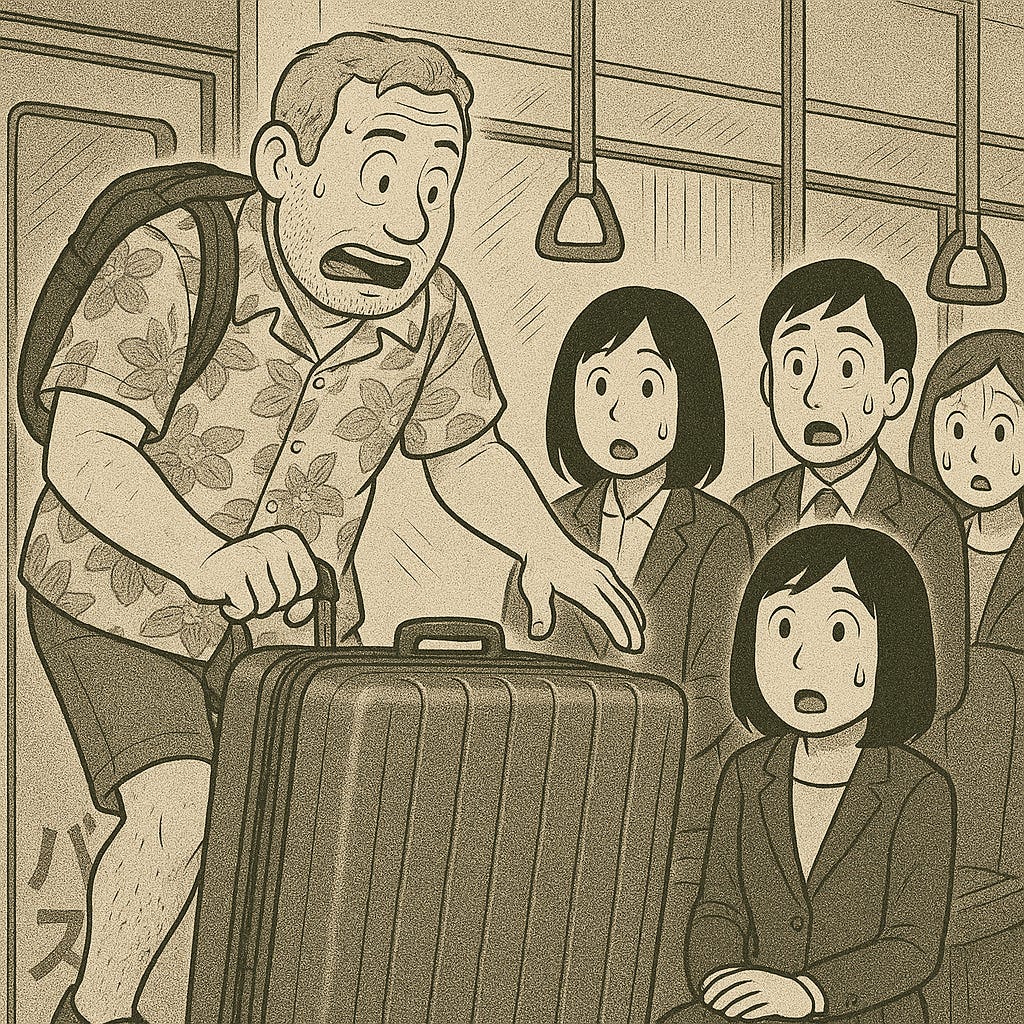Should You Visit Japan?
Is it ethical to do so in the age of overtourism? A related podcast. Japan etiquette lesson.
When I first arrived in Japan in 1992, the country received about 3 million foreign tourists annually. Last year (2024), that number reached 36 million—an increase of 1200 percent! Needless to say, this explosion in tourist numbers has changed Japan. I mean, in my early days in Kyoto, it was possible to walk through the Arashiyama Bamboo Grove and have the place to yourself. That’s totally unimaginable now, when the place feels more like the Arashiyama Selfie Stick Forest.
These days, all we hear about is “overtourism,” and I even get emails from people asking me:
“Is it okay to visit Japan now?”
First, as you know, I have a vested interest in people visiting Japan because my business is Japan tourism. But I also have a special insight into the effects of overtourism in Japan: My wife is from Kyoto and her family lives in Arashiyama, which is one of the places in Kyoto most affected by crowds of foreign tourists. We hear from her family members how foreign tourists walk in the streets and block local buses, and how the same tourists board those buses with huge suitcases, making daily commutes and errands difficult for locals.
So, what do I tell people? Before I answer, let’s take a better look at the problem.
The real problem is not overtourism per se, rather, it’s two key issues: poorly distributed tourism and a small minority of tourists who behave badly. Let’s look at these one at a time.
Poorly Distributed Tourism
The fact is, there are only four cities in Japan where overtourism is even a factor: Tokyo, Kyoto, Nara and Kanazawa. In addition to these cities, overtourism can also be a problem in Shirakawa-go (with its thatched-roof houses), Niseko (a popular ski destination) and Hakone (known for its onsen/ryokan/sightseeing). Sure, a few other places can get crowded with tourists in certain seasons, but it’s not really a problem.
In the cities that suffer from overtourism, it’s quite easy to avoid the tourists. Take Kyoto, for example. In Kyoto there are only a handful of sites that get really crowded: Kinkaku-ji, Fushimi-Inari, the Bamboo Forest, Nishiki Market, Ginkaku-ji, and Gion. In each case, a short distance from these sites, you’ll find attractions that are almost completely ignored by tourists: Honen-in, one of the loveliest temples in Kyoto, can be completely empty when Ginkaku-ji, a mere five minutes’ walk away, is packed with tourists. Even Arashiyama’s Bamboo Forest and Fushimi-Inari’s shrine gates can be visited peacefully if you simply enter from a different direction or go early on a weekday.
Honen-in Temple in Kyoto
So, for those who are worried about contributing to or worsening the problem, the answer is simple:
If crowding is the problem, just don’t become part of the crowd.
For me and many of my tour guests, this goes without saying. I mean, I find it impossible to enjoy a place if it’s too crowded, and it doesn’t matter if the crowds are locals or tourists. And apart from the lines for the immigration counters at Narita or Haneda, which are unavoidable, I don’t think it’s ever worth it to wait on line in Japan. When I see lines of people in Japan standing outside some “Insta-famous” restaurant, I shake my head. Why waste any time on line during your precious vacation when there’s almost certainly another restaurant right around that corner that is just as good?!
But more importantly, since it’s the crowds themselves that are causing distress to the locals, it’s best not to join those crowds. Likewise, if foreign tourists are monopolizing local transport like buses, it’s better to take alternative means of transport like trains, subways and taxis (and anyway, buses are the least comfortable way to explore Japanese cities).
Just as importantly, consider visiting other areas of Japan. That’s not to say you should skip Tokyo and Kyoto - you shouldn’t - but you should try to visit some other areas of Japan. The southern island of Kyushu has it all - great hiking, fantastic cities, delicious food, bubbling onsens and friendly people - and most tourists never go there. And Japan’s outer islands like Iriomote, Ishigaki, the Izu Islands, and the Ogasawara Islands are almost totally ignored by tourists. The fact is: Japan is much larger than you think and most of the country suffers not from overtourism, but from a serious case of undertourism.
For tips on how to avoid crowds in Japan see my articles on How to Avoid Crowds and Lines in Japan and How to Escape the Crowds in Kyoto. You might also be interested in my post where I argue that It’s Time to Rethink Japan Tourism.
Poorly Behaved Tourists
To tell the truth, if all the people who crammed into places like Arashiyama behaved with the same level of courtesy as the locals, I honestly don’t think we’d hear any complaints about overtourism. Unfortunately, while most visitors to Japan are very respectful of the people and culture, there’s always a small minority of people who behave egregiously. Here are some things my guides and my Japanese family members see all the time:
• People blocking traffic to take selfies
• Tourists sitting in seats on buses and trains reserved for the elderly, pregnant women, women with small children, and people with disabilities
• Travelers taking large suitcases onto buses and trains
• People cutting lines at tourist sites, shops and train stations
• Visitors getting angry at shop clerks and waitstaff who don’t speak English
• People speaking loudly or speaking on the phone on public transport and in restaurants
Unfortunately, the sad fact is this: Those who need this message the most are often the hardest to reach and are likely to ignore it even if they do hear it. Still, it’s good to be aware of what behavior is problematic and to make sure that everyone in your party doesn’t do anything on the list above.
So, Should You Visit Japan?
When I talk to people wondering whether they should visit Japan, it’s clear that they are worried about two things: 1) feeling unwelcome in the country and 2) making the problem of overtourism worse. Let’s take each of these in turn:
1) Will you feel unwelcome in Japan?
We guide well over a thousand foreign visitors to Japan every year. My guides hear directly from them about their experiences in the country and we often get emails from our guests after they return home. The first thing they tell us - before they mention the great food, the immaculate trains and the surprisingly low prices - is how friendly, polite and helpful the people are. And I myself travel all around the country every year and I never feel unwelcome. I speak Japanese with locals everywhere I go and I often ask them about their concerns with tourists. None of them say they want the tourists to stay away. Rather, when they complain (which is pretty rare), they only complain about the things I’ve mentioned above.
2) Will you make the problem of overtourism worse?
As discussed above, if you simply avoid the overcrowded places or visit when they are less crowded, you won’t worsen the problem.
Furthermore, many places in Japan are highly dependent on tourist dollars. Kyoto used to be home to a thriving kimono industry, but this has almost entirely disappeared as Japanese women adopted Western fashion, and many other traditional industries have also nearly gone extinct. Despite the troubles with crowds and unruly tourists, Kyoto needs tourists to survive. Avoiding Japan altogether turns a small problem for a limited number of people - and one that has a relatively easy solution - into a major problem for many, with no easy solution.
In a word: the answer is not less tourism; it’s better tourism. So, yes, I think you should visit Japan if you have the chance.
A Final Thought
On a deep level, what we really need to practice is conscious tourism. Japan is a culture where modesty, reserve and harmony are all highly prized. If we take a leaf out of their book and remain mindful of how our presence affects those around us, we will find that we are welcomed with open arms. Everything follows from this: We will speak a bit more quietly, we will give up seats to those who need them, we will not get in the way of people trying to go about their daily business, and we will understand that locals want to help, even if they don’t speak our language.
Japan Etiquette Lesson
At Chris Rowthorn Tours, we’ve put together a lighthearted lesson that we deliver in an interactive Zoom lesson. It’s delivered by one of our veteran Kyoto guides who created the lesson based on years of watching foreign visitors to Japan interact with locals. If you’re one of those travelers who really cares about respecting the people and cultures you visit, this lesson is for you. For more details, visit our website.
Tim Ferriss/Craig Mod Podcast on Japan
If you’re at all interested in Japan, you’ll love a recent podcast by Tim Ferriss in which he interviews Craig Mod. Tim has spent a lot of time in Japan and it’s clear that it changed his life. Craig lives in Japan and has explored the country more deeply than almost anyone I know. Among the topics they discuss are the freakish affordability of Tokyo and Craig’s new book called Other Thing in which he recounts a long walk across the Kii Peninsula (southern Kansai). Most importantly, Craig discusses his efforts to attract more tourists to some of Japan’s lesser-known cities like Toyama and Morioka. If you’re concerned about overtourism in Japan, this two-part podcast is highly recommended.











Hello Chris: I follow your newsletter regularly, thank you very much.
My wife and I used your guide services in April 2016, and your guides were absolutely wonderful. We have hopes to return to Japan and use your services again. When we go, we want to see the less traveled areas and really get close to the culture. We will be asking you for assistance as we are sure you will be most helpful.
Doug Johns - USA